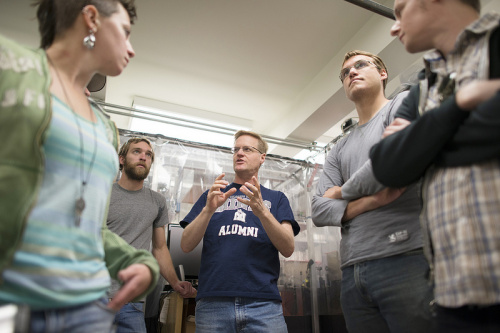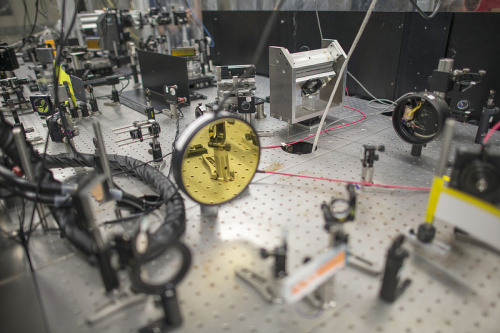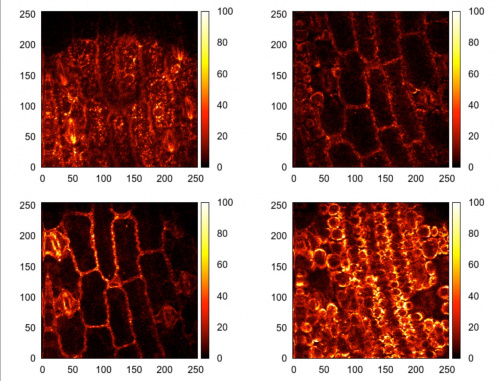First off, a quick plug - we're proud to be one of the sponsors an awesome new artist-in-residency program by our friends at Public Knowledge/Eyebeam! The idea of the program is to find artists, engineers, designers, curators, and creative technologists who will use some of the technology that Public Knowledge advocates for (3D-printing, open source hardware, etc.) to help draw attention to one of the issues they focus on, which range from net neutrality to copyright reform. Their goal is to make policy issues more engaging, and encourage people to think about approaching and solving these important issues in new ways. We feel very strongly about their motivations, and we can't wait to see what the residents can do! Now on to our Engineer Thursday post:
The Death Star. Sharks with freakin’ laser beams. The precursors to phasers for Kirk and Spock. For geeks of all types, lasers are just plain awesome. While most typical laser applications fall into the science fiction realm, some mind-blowing real world applications of lasers do actually exist. Laser technology has enabled great advances in biological studies and the medical field, including applications such as tattoo removal, laser scapels, and worm mind control. Many of these developments are being worked on in university labs across the country, including the Squier Group Laser Microscopy Lab at the Colorado School of Mines. A lucky group of Funions recently got to tour this lab.
Jeff Squier explaining lasers to the SparkFun crowd
The lab, run by Jeff Squier, is part of the Center for Microintegrated Optics for Advanced Bio-imaging and Control (MOABC). The lab is developing new scanning and imaging techniques for studying biological processes in different spatial and temporal scales, as well as possible surgical applications of lasers. The lab currently has several different lasers they are using for these endeavors, including a terawatt Ti:Sapphire laser.
An example of one laser optics array
The images below show data collected from a 3D microscope of a maize leaf. These images are collected by beaming laser light at an object through a complex collection of optics. Various stages of optics alternate splitting and focusing the light, causing the laser to excite photons in the material being scanned.
As the beam moves across the sample, the excited photons are recorded for each scanning position and are then processed all together to create an image showing the structure of the sample. While Confocal Laser Scanning Microscopy isn't a new technology, groups like the Squier lab are starting to hack them and create their own versions, instead of having to buy systems worth tens of thousands of dollars.
Maize Leaf (Photo courtesy of Jeff Squier)
For scale, the left and bottom axes shows micrometers, and the right color bar shows photon counts. If that wasn’t impressive enough, the best thing about this scanning laser microscope is that it is synchronized using an Arduino and open-source code. The lab isn’t quite ready to post the code yet as they are still fine-tuning the system, but once they get a bit farther with the research, it should be available for anyone to check out.
Jeff’s lab has also developed a femtosecond laser (yes, you read that right: femto = 10-15. These lasers are fast. For the physics nerds out there, that's the amount of time required for light to travel 299.9 nm.) from laser diodes which we got an opportunity to check out. The femtosecond laser is used with lenses that focus the beam in both space and time and is a very useful imaging tool.
Laser Focus (Photo courtesy of Jeff Squier)
The 800 nm laser shown above is focused into a cell containing a fluorescing dye, which then allows the team to follow the focus of the laser. This process of using fluorescent dye for tracking the focus is known as two photon fluorescence. The team is also investigating the use of these femtosecond lasers for eye surgeries. Due to the ability to control these lasers in space and time, they can be used to create extremely precise cuts. These precise cuts have multiple implications, including faster healing times for patients undergoing laser eye surgery and less invasive treatment options.
Currently the lab is also working on developing a handheld health testing device by etching channels into glass squares which can mechanically separate and filter blood particles. This palm-sized filtering system could eventually then be used to do home health tests simply using a prick of the finger, instead of requiring going to a doctor's office to have several vials of blood drawn.
Needless to say, the Squier lab was an inspiring and exciting tour. Every one of us walked out of there with a gleam in our eyes, dreaming of what we could do with such powerful lasers. You can see some more pictures of our tour here.










My company builds laser products... On one wall in our production facility, somebody with a sense of humor made up a new warning placard that says:
"Danger! Do not stare into laser with remaining eye"
If you are going to play with lasers - and lest's face it, we're all going to play with lasers - it is absolutely imperative that you wear the proper lens of eye protection for the type of laser you are using. They aren't cheap, but don't skimp on these!
The other option is to buy a good eye patch, and put it over the eye you would like to keep.
Just remember the two rules of laser safety - don't look into the laser beam, and don't chew on the power supplies. Laser accidents happen at the speed of light, you know.
I think I see my old lab notebook in one of those pictures...
Interestingly enough, a significant number of "laser" accidents are actually caused by the associated electronics. Most of the supplies draw tens of amps, and a lot of the device electronics like piezoelectrics are high-voltage.
That said, eye safety really is key - especially with visible laser pointers, let alone the big lasers like these. Many are frequency-doubled (green from NIR) and don't filter the NIR light!
Here's my version of a laser warning sign: (http://img.photobucket.com/albums/v239/jpelletier/Autres/WarningJamesBondLaser.jpg)
Hah, we need some of those around SparkFun.
light beams....good...
Dr. Evil: You know, I have one simple request. And that is to have sharks with frickin' laser beams attached to their heads! Now evidently my cycloptic colleague informs me that that cannot be done. Ah, would you remind me what I pay you people for, honestly? Throw me a bone here! What do we have?
Number Two: Sea Bass.
Dr. Evil: [pause] Right.
Number Two: They're mutated sea bass.
Dr. Evil: Are they ill tempered?
Number Two: Absolutely.
Dr. Evil: Oh well, that's a start.
Come on now.... A Laser isn't truly Awesome until you have to get FAA clearance to fire the thing so you don't run the risk of blinding some pilot in flight. :-) (Been there, done that.)
Not stricitly laser related but interesting all the same
Stratasys is buying another 3D printer manufacturer, MakerBot, for $403 million in stock.
Unfortunate.
IMA FIRIN MAH LAZAH